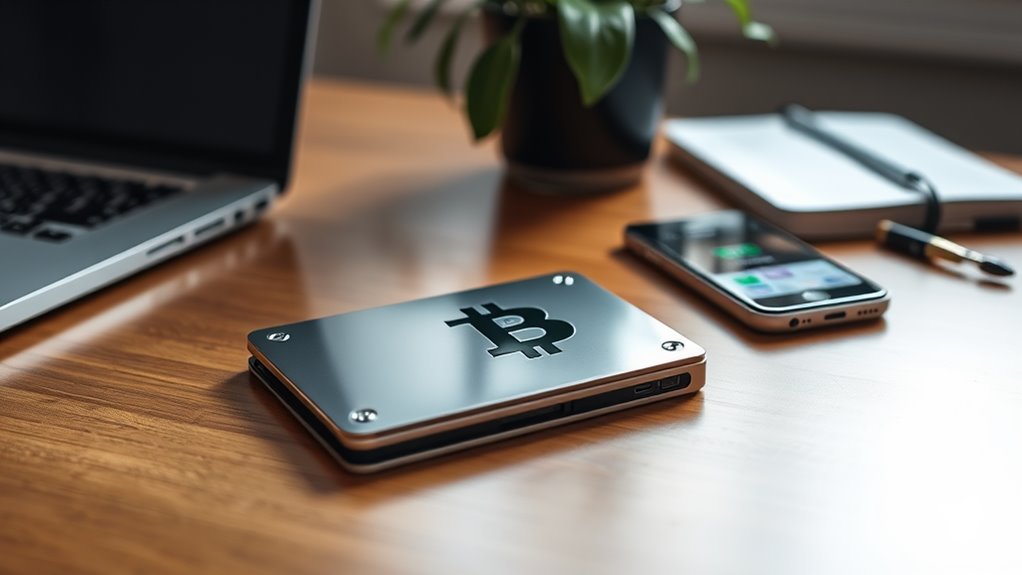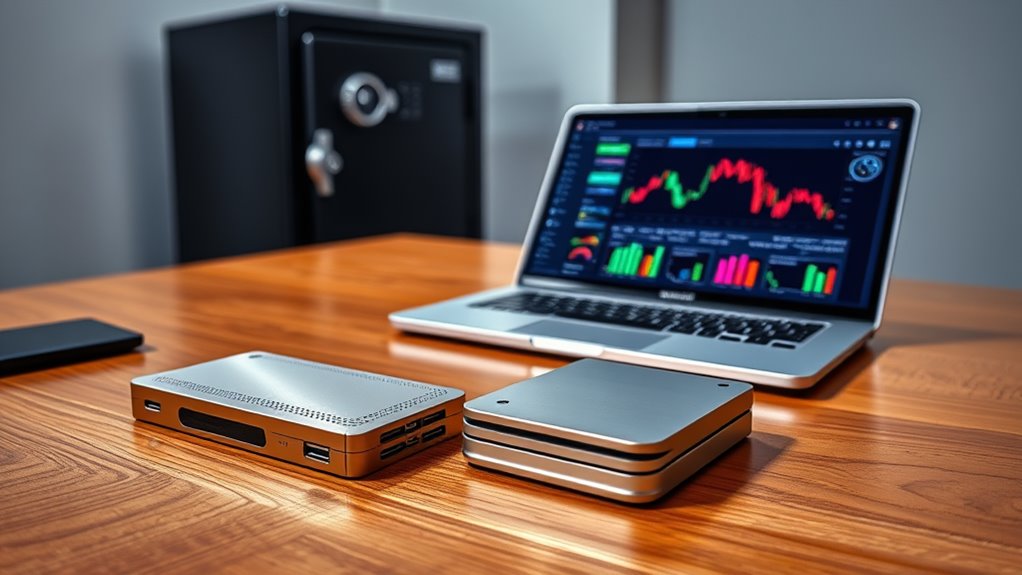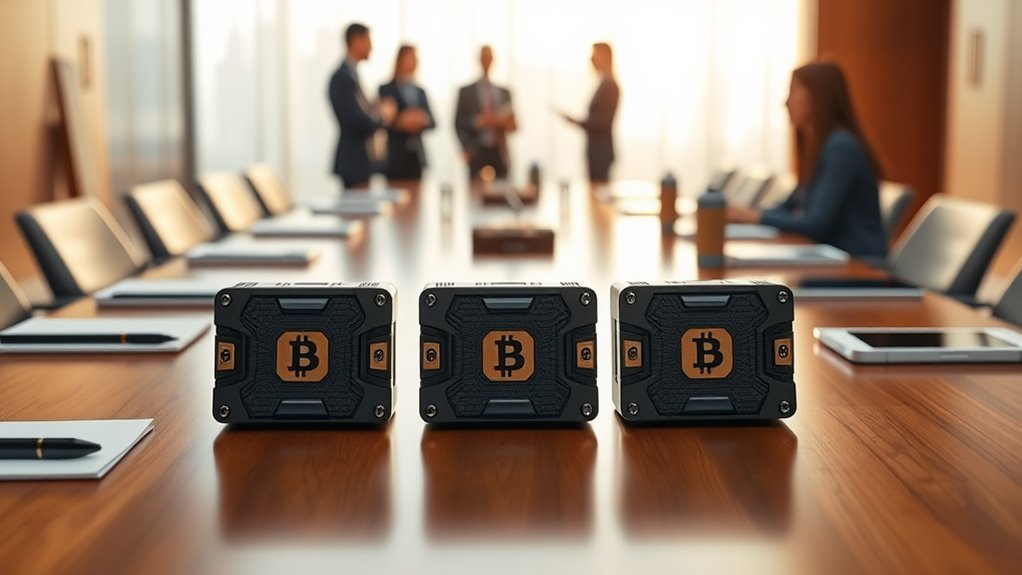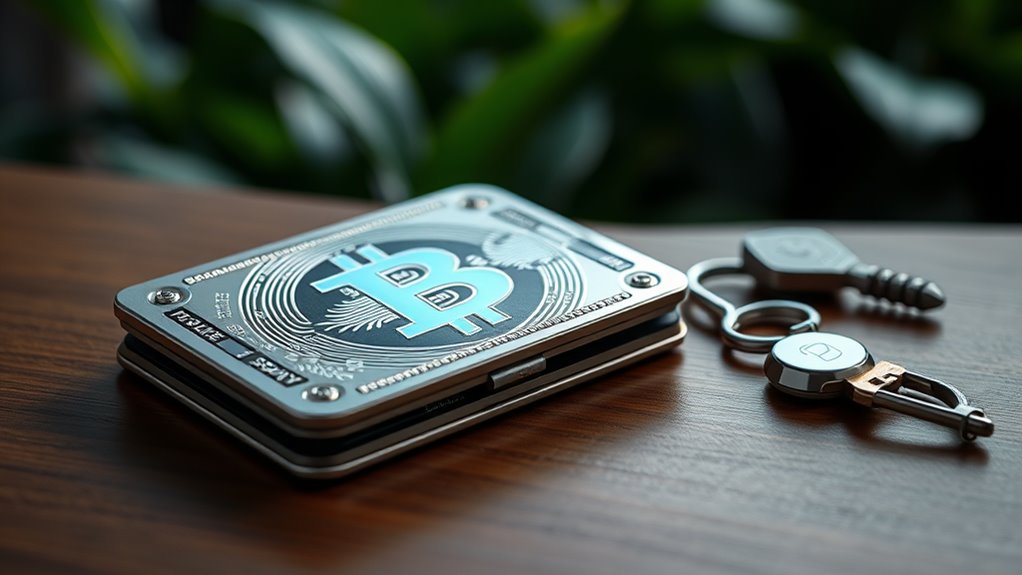
Bitcoin Wallets: How to Securely Store BTC
Securely storing Bitcoin requires choosing the right wallet type for your needs. Hardware wallets offer maximum security for long-term storage, while hot wallets provide convenience for small amounts. Essential practices include enabling two-factor authentication, using strong passwords, storing recovery phrases offline in multiple secure locations, and keeping wallet software updated. For institutional holdings, multi-signature wallets distribute risk by requiring multiple keys for authorization. These fundamental security layers protect digital assets from both online threats and physical vulnerabilities.
Key Takeaways
- Use hardware wallets for long-term storage, as they provide offline security for large Bitcoin holdings.
- Enable two-factor authentication on all wallet accounts to prevent unauthorized access.
- Store seed phrases offline in multiple secure locations such as fireproof safes.
- Consider multi-signature wallets requiring multiple keys for transaction authorization, reducing single points of failure.
- Keep wallet software updated to patch security vulnerabilities and protect against new threats.
Bitcoin Wallets: How to Securely Store BTC

Securing Bitcoin requires implementing multiple layers of protection to safeguard digital assets from various threats. Experts recommend using strong, unique passwords and enabling two-factor authentication (2FA) for all wallet accounts.
For maximum security, users should store seed phrases offline in secure locations away from potential breaches. Hardware wallets like Trezor or Ledger provide enhanced security through cold storage, keeping Bitcoin offline and minimizing exposure to online threats.
For additional protection, consider implementing multi-signature wallets that require multiple approvals for transactions. Regular software updates are essential to patch vulnerabilities.
Remember that cryptocurrency wallets store private keys, not the actual coins themselves, which remain recorded on the blockchain.
Common mistakes to avoid include storing all Bitcoin in a single wallet, sharing private keys, and conducting transactions over public Wi-Fi networks. Using a combination of security measures considerably reduces the risk of unauthorized access or theft.
Understanding the Types of Bitcoin Wallets

Bitcoin wallets can be categorized along two critical dimensions: temperature (hot vs. cold) and custody type.
Hot wallets maintain an internet connection for convenient transactions, while cold wallets remain offline to maximize security against potential cyber threats.
The custody aspect further distinguishes between custodial wallets managed by third parties and non-custodial options where users retain complete control over their private keys.
Some Bitcoin wallets also offer staking capabilities that allow users to generate passive income while storing their digital assets.
Hot vs. Cold
The fundamental distinction in wallet security revolves around internet connectivity, creating two main categories: hot and cold wallets. Hot wallets remain connected to the internet, offering convenience for frequent transactions but with increased vulnerability to hacking attempts. Cold wallets, conversely, operate offline, dramatically reducing digital attack vectors. Beginning cryptocurrency users often benefit from exploring hardware wallet options that provide an ideal balance of security and usability.
| Feature | Hot Wallets | Cold Wallets |
|---|---|---|
| Security | Lower (internet exposure) | Higher (offline storage) |
| Convenience | High (easy access) | Lower (physical interaction) |
| Recommended Use | Small amounts, daily transactions | Large holdings, long-term storage |
Most security experts recommend a dual wallet strategy—keeping small amounts in hot wallets for convenience while securing larger holdings in cold storage. This approach balances accessibility with protection, ensuring users can transact easily while safeguarding their primary investments from potential threats.
Custody Matters
Beyond the hot-cold distinction lies another fundamental aspect of Bitcoin wallet security: custody. This refers to who controls the private keys that access your Bitcoin.
Custodial wallets, typically offered by exchanges like Coinbase, hold your private keys on your behalf. They provide convenience and easy account recovery but introduce counterparty risk—your funds could be vulnerable if the exchange is hacked or becomes insolvent.
Non-custodial wallets give users complete control over their private keys. This eliminates counterparty risk but places full responsibility for security on the user. Losing access to your private keys or seed phrase in a non-custodial setup means permanent loss of funds.
Each wallet type—web, mobile, desktop, hardware, and paper—offers different custody arrangements, with hardware wallets providing the strongest security while maintaining user control. For maximum protection of your digital assets, consider implementing multi-signature protection which requires multiple private keys to authorize transactions.
Cold Storage vs. Hot Wallets: Which Is Right for You?

When deciding how to store digital assets, cryptocurrency users face a fundamental choice between security and convenience.
Hot wallets offer accessibility and ease of use for frequent transactions, while cold storage provides enhanced security for long-term holdings by keeping assets offline.
The decision should be based on:
- Transaction frequency – Hot wallets suit daily users, while cold storage is better for infrequent access
- Amount of cryptocurrency – Larger holdings warrant the additional security of cold storage
- Technical comfort level – Cold storage requires more technical understanding than user-friendly hot wallets
Many experienced users employ both solutions simultaneously, keeping small amounts in hot wallets for convenience while securing the majority of their assets in cold storage for protection against online threats. Regardless of your storage choice, implementing two-factor authentication significantly enhances your cryptocurrency's security against unauthorized access.
Hardware Wallets: The Gold Standard for Bitcoin Security

While hardware wallets offer robust security against digital threats, they remain vulnerable to physical attacks if the device falls into the wrong hands.
Users should establish thorough backup strategies, including secure storage of recovery phrases in fireproof or waterproof containers, preferably in multiple locations.
Regular verification of recovery phrase integrity, combined with periodic firmware updates, creates a resilient security system that protects Bitcoin holdings even if the physical device is compromised or destroyed.
Enabling two-factor authentication provides an additional security layer that significantly reduces the risk of unauthorized access to your Bitcoin wallet.
Physical Threat Protection
Security extends beyond digital walls when it comes to Bitcoin storage, making hardware wallets the physical fortress for cryptocurrency assets. These devices employ tamper-resistant designs with secure element chips that keep private keys isolated from internet threats while providing encrypted PIN protection. Unlike online wallets, hardware options leverage blockchain technology's security while maintaining complete offline protection.
Physical security threats can be mitigated through:
- Secure recovery phrase storage – keeping backup phrases in fireproof, waterproof locations separate from the device itself
- Supply chain protection – purchasing only from authorized manufacturers to avoid compromised devices
- Regular firmware updates – maintaining the latest security patches to address potential vulnerabilities
Even if a hardware wallet is stolen, multiple security layers prevent thieves from accessing funds without both the physical device and correct PIN. This multi-layered approach creates a thorough defense system against both digital and physical threats.
Backup Strategy Essentials
The strongest hardware wallet setup remains incomplete without a robust backup strategy to protect against device failure, loss, or damage.
Recovery phrases, often called seed phrases, are the cornerstone of any backup plan, allowing users to restore wallet access if their device becomes compromised or inaccessible.
These phrases must be stored in secure locations, preferably in fireproof safes or other protected environments.
Many security experts recommend storing recovery information in multiple secure locations to prevent complete loss from a single point of failure.
Some advanced hardware wallets implement Shamir Secret Sharing, dividing the recovery information across multiple components for enhanced security.
When creating backups, users should avoid digital storage methods that could be compromised by malware.
Physical, offline storage of recovery phrases provides the highest level of protection against both online threats and hardware failures.
Understanding the public and private keys relationship is essential when backing up your wallet, as these cryptographic elements form the foundation of Bitcoin's ownership verification system.
Multi-Signature Protection for Institutional Bitcoin Holdings

For institutions managing substantial Bitcoin holdings, multi-signature wallets represent a critical security advancement in digital asset custody. These wallets require multiple private keys to authorize transactions, greatly reducing vulnerabilities associated with single points of failure.
Multisig arrangements, typically described as m-of-n quorums, offer institutions several key advantages:
- Enhanced security through distributed authorization, requiring approval from multiple key holders before funds can be moved.
- Operational redundancy that enables key recovery if one device or individual becomes unavailable.
- Compliance flexibility that can be tailored to meet specific regulatory requirements and internal governance structures.
When implemented properly, multisig protection integrates effectively with cold storage solutions and can be further enhanced through additional security methods like Shamir's Secret Sharing and Multi-Party Computation for extensive institutional custody.
Common Security Mistakes and How to Avoid Them

While multi-signature protection offers robust security for institutional users, individual Bitcoin holders face numerous everyday security pitfalls that can lead to devastating asset losses.
Common mistakes include incorrect backup of seed phrases, forgotten passphrases, and inadequate device security measures like weak passwords.
Network operation errors frequently result in permanent fund loss, particularly when users send Bitcoin to incorrect network addresses or fail to verify recipient information.
Phishing attacks remain prevalent, with scammers creating convincing fake wallet interfaces to steal private keys.
Physical threats pose equally serious risks, including device theft, fire or water damage to backup materials, and improper storage of sensitive recovery information.
To mitigate these dangers, users should implement secure seed phrase storage, use strong unique passwords, keep wallet software updated, and enable two-factor authentication whenever possible.
Understanding blockchain technology fundamentals is essential for safely executing cryptocurrency transactions and avoiding common pitfalls that could compromise your Bitcoin holdings.
Advanced Security Practices for Bitcoin Storage

Advanced security practices for Bitcoin storage extend well beyond basic security measures, requiring Bitcoin holders to implement sophisticated protection mechanisms. These practices guarantee thorough protection against both digital and physical threats.
- Key Management – Encrypt private keys using AES-256 algorithms and consider using hardware-backed storage solutions like hardware security modules (HSMs) or secure enclaves found in modern smartphones.
- Multi-Signature Solutions – Implement multi-signature wallets that require multiple private keys for transaction authorization, distributing responsibility among different key holders.
- Network Security – Secure all communications with TLS/SSL encryption, implement certificate pinning to prevent man-in-the-middle attacks, and avoid accessing wallets through public Wi-Fi networks that may compromise sensitive information.
Frequently Asked Questions
How Do I Recover Lost Bitcoin if I Forget My Password?
Recovering lost Bitcoin requires using available recovery options. Users can utilize password hints, professional recovery services, or restore access with their mnemonic phrase. Without these, investment in brute force tools remains a challenging last resort.
Can Quantum Computing Break Bitcoin Wallet Security in the Future?
Quantum computing poses a theoretical future threat to Bitcoin security. Sufficiently powerful quantum computers could break the cryptographic algorithms protecting wallets, particularly those with exposed public keys or reused addresses.
Are Paper Wallets Still Considered Secure for Long-Term Bitcoin Storage?
Like a castle's stone wall resisting time's assault, paper wallets remain theoretically secure for long-term Bitcoin storage. However, many experts now recommend hardware wallets due to paper's physical vulnerabilities and handling complications.
How Do Inheritance Plans Work for Bitcoin Wallet Access?
Bitcoin inheritance plans involve custodial services, multi-signature wallets, or decentralized solutions that enable beneficiaries to access funds after the owner's death. These arrangements often include legal documentation and trusted third parties for verification purposes.
What Insurance Options Exist for Bitcoin Wallet Protection?
With cryptocurrency theft exceeding $3.2 billion in 2022, insurance options for Bitcoin wallet protection include specialized policies from providers like Hotaling and Boost, covering risks such as hacking, phishing attacks, and private key loss.
Conclusion
Securing your Bitcoin requires selecting the appropriate wallet for your needs and following proven security practices. Whether you choose cold storage for long-term holdings or hot wallets for daily transactions, implementing multiple layers of protection remains essential. As the old saying goes, "Don't put all your eggs in one basket"—diversify your storage methods and regularly update your security measures to safeguard your digital assets against evolving threats.












